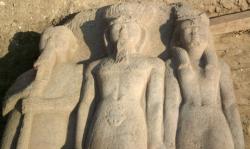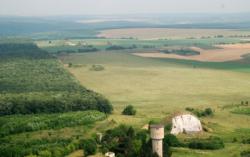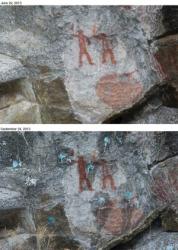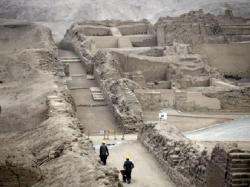INSTITUT SUPERIEUR D'ANTHROPOLOGIE
INSTITUTE OF ANTHROPOLOGY
ONLINE COURSES / COURS A DISTANCE
FALL TERM : OCTOBER 2013
REGISTER NOW
EGYPTE –  Tel-Basta - A German-Egyptian excavation mission in the Nile Delta town of Tel-Basta unearthed today a life-size statue of the nineteenth dynasty king Ramses II carved in red granite. The statue, at 195cm high and 160cm wide, was found accidently during a routine excavation carried out by the joint mission. It was discovered in the so-called Great Temple area's eastern side, inside the temple of cat goddess Bastet in Sharkiya's Tel-Basta. Antiquities minister Mohamed Ibrahim explained that the newly-discovered statue depicts king Ramses II standing between the goddess Hathor and the god Ptah. On its back, Ibrahim continued, a hieroglyphic text and the cartouche of the king are engraved. Mohamed Abdel Maqsoud, head of the Ministry of State of Antiquities' (MSA) Ancient Egyptian department, added that the mission uncovered another statue carved in sand stone which depicts a yet-unidentified New Kingdom top official. A hieroglyphic text offering the statue to the goddesses bastet and sekhmet and the god horakhti is engraved on its back. This statue is 35cm in height and 25cm in width, according to Abdel Maqsoud. "This is a very important discovery that sheds light on the history of Tel-Basta in general and on this area in particular," Abdel Maqsoud told Ahram Online. He added that the discovery, in addition to previous finds in the area, suggests that Tel-Basta was once home to a New Kingdom temple dedicated to King Ramses II, which might be uncovered in the future.
Tel-Basta - A German-Egyptian excavation mission in the Nile Delta town of Tel-Basta unearthed today a life-size statue of the nineteenth dynasty king Ramses II carved in red granite. The statue, at 195cm high and 160cm wide, was found accidently during a routine excavation carried out by the joint mission. It was discovered in the so-called Great Temple area's eastern side, inside the temple of cat goddess Bastet in Sharkiya's Tel-Basta. Antiquities minister Mohamed Ibrahim explained that the newly-discovered statue depicts king Ramses II standing between the goddess Hathor and the god Ptah. On its back, Ibrahim continued, a hieroglyphic text and the cartouche of the king are engraved. Mohamed Abdel Maqsoud, head of the Ministry of State of Antiquities' (MSA) Ancient Egyptian department, added that the mission uncovered another statue carved in sand stone which depicts a yet-unidentified New Kingdom top official. A hieroglyphic text offering the statue to the goddesses bastet and sekhmet and the god horakhti is engraved on its back. This statue is 35cm in height and 25cm in width, according to Abdel Maqsoud. "This is a very important discovery that sheds light on the history of Tel-Basta in general and on this area in particular," Abdel Maqsoud told Ahram Online. He added that the discovery, in addition to previous finds in the area, suggests that Tel-Basta was once home to a New Kingdom temple dedicated to King Ramses II, which might be uncovered in the future.
http://english.ahram.org.eg/NewsContent/9/40/83133/Heritage/Ancient-Egypt/Lifesize-statue-of-king-Ramses-II-found-in-Sharkiy.aspx
TURQUIE –  Edirne - Excavation works carried out in the square in front of the Selimiye mosque in the northwestern province of Edirne have revealed the remains of Yemişkapanı Khan, which is estimated to date back to 425 years ago. The area of excavations was extended after the finding. During the works, the wall remains of Yemişkapanı Khan were found. The khan is known to have been built in 1588 and served as a fruit and vegetable bazaar for the public in the Ottoman era. The wall was revealed at a two-meter depth and officials decided to continue excavations to reach the continuation of the wall. The Yemişkapanı Khan, located in the big square in front of the Selimiye Mosque, which is on the UNESCO World Heritage List, was built in 1588. The khan collapsed in 1937 because of disrepair and its pieces remained underground in the square. The Selimiye Mosque was commissioned by Sultan Selim II and was built by architect Mimar Sinan between 1569 and 1575. It was considered by Sinan to be his masterpiece and is one of the highest achievements of Islamic architecture.
Edirne - Excavation works carried out in the square in front of the Selimiye mosque in the northwestern province of Edirne have revealed the remains of Yemişkapanı Khan, which is estimated to date back to 425 years ago. The area of excavations was extended after the finding. During the works, the wall remains of Yemişkapanı Khan were found. The khan is known to have been built in 1588 and served as a fruit and vegetable bazaar for the public in the Ottoman era. The wall was revealed at a two-meter depth and officials decided to continue excavations to reach the continuation of the wall. The Yemişkapanı Khan, located in the big square in front of the Selimiye Mosque, which is on the UNESCO World Heritage List, was built in 1588. The khan collapsed in 1937 because of disrepair and its pieces remained underground in the square. The Selimiye Mosque was commissioned by Sultan Selim II and was built by architect Mimar Sinan between 1569 and 1575. It was considered by Sinan to be his masterpiece and is one of the highest achievements of Islamic architecture.
http://www.hurriyetdailynews.com/historical-inn-comes-to-light.aspx?pageID=238&nID=55680&NewsCatID=375
ROYAUME UNI – Sandy - Archaeologists across the country were thrilled by a wealth of Roman artefacts unearthed at a secret dig in Sandy cemetery 25 years ago this week. Thirty-seven coins, three brooches, pottery, bronze pins, the remains of a building and carved ivory were all discovered. The ivory was described as being the finest example of its kind north of the Alps, and one piece of pottery was unique to Sandy. Roman expert Martin Henig of the Oxford Institute of Archaeology said: “The quality and stage of preservation leads us to expect that results of widespread excavation would be sensational.” The field team had started digging a five by six metre survey site the previous December following the discovery of an ancient skull and only Sandy Town Council were informed under strict secrecy in case treasure hunters moved in.
http://www.biggleswadetoday.co.uk/news/nostalgia/secret-dig-unearths-treasures-1-5542161
BULGARIE – x Sboryanovo - Much of the grounds of the Bulgarian archaeological reserve "Sboryanovo" near the town of Isperih and the village of Sveshtari have become a field planted with alfalfa. Although it is State property, an unknown farmer is using the historical site for personal profit, alarms bTV. Just last year a unique Thracian gold treasure was discovered there, and less than a month ago, Bulgarian archaeologists found a unique chariot. Archaeologists say that if cultivation of the land becomes regulated, the profits from the production must be used to fund their research, as financing is currently insufficient. The discovery, 31 years ago, of the Thracian Sveshtari tomb is seen as an archaeological sensation and the site is included in the world cultural-historical heritage of UNESCO.
Sboryanovo - Much of the grounds of the Bulgarian archaeological reserve "Sboryanovo" near the town of Isperih and the village of Sveshtari have become a field planted with alfalfa. Although it is State property, an unknown farmer is using the historical site for personal profit, alarms bTV. Just last year a unique Thracian gold treasure was discovered there, and less than a month ago, Bulgarian archaeologists found a unique chariot. Archaeologists say that if cultivation of the land becomes regulated, the profits from the production must be used to fund their research, as financing is currently insufficient. The discovery, 31 years ago, of the Thracian Sveshtari tomb is seen as an archaeological sensation and the site is included in the world cultural-historical heritage of UNESCO.
http://www.novinite.com/articles/154256/Grounds+of+Bulgarian+Archaeology+'Sensation'+Turned+into+Meadow
USA –  Kootenay - Government archaeologists are trying to determine how to clean up some vandalism of First Nation rock art after someone apparently blasted paintball pellets at an ancient pictograph near Nelson, B.C. Amateur photographer Alistair Fraser first noticed the pictograph that hangs above Kootenay Lake was damaged last week. Blue paint blotches now stain a scene of what appears to be two native hunters.
Kootenay - Government archaeologists are trying to determine how to clean up some vandalism of First Nation rock art after someone apparently blasted paintball pellets at an ancient pictograph near Nelson, B.C. Amateur photographer Alistair Fraser first noticed the pictograph that hangs above Kootenay Lake was damaged last week. Blue paint blotches now stain a scene of what appears to be two native hunters.
http://www.cbc.ca/news/canada/british-columbia/kootenay-pictographs-vandalized-with-paintball-pellets-1.1894279
PEROU –  Cao - Theater lovers of Lima are buzzing about the debut of the new play “Cao(s): Visiones de la dama moche”. The play, written by director Rebeca Raez, explores the last days of the famous Lady of Cao. Raez told El Comercio that she’d become fascinated with the story of the Lady of Cao ever since she’d heard of its discovery. Discovered by Peruvian archaeologist Régulo Franco in 2006, the Lady of Cao is one of the most significant archaeological discoveries in the Americas of the last 10 years. According to El Comercio, the Lady of Cao was around 25 years old when she died, probably from complications related to childbirth. The enduring allure of the Lady of Cao lies partly in her mystery. Archaeologists believe she was an important leader for the Moche, possibly even semi-divine in the eyes of her people. She was found buried in lavish jewelry of gold, silver, turquoise, and lapis lazuli. Though the well-known figures of ancient history are by far mostly men, the Lady of Cao is a young women who ruled. According to El Comercio, director Rebeca Raez wants to explore a psychological, even magical side to the mysterious lady. “I’m not trying to present a history report with this show, she said, “What I’m trying to do is dive into the mythological universe of the Lady of Cao. I didn’t want to create something static, a traditional vision that we’ve already seen. We decided to go into the universe of the Moche gods. I mean, the Lady of Cao herself is a demigod! For me, she has a kind of magic that operates on a supernatural plane.”
Cao - Theater lovers of Lima are buzzing about the debut of the new play “Cao(s): Visiones de la dama moche”. The play, written by director Rebeca Raez, explores the last days of the famous Lady of Cao. Raez told El Comercio that she’d become fascinated with the story of the Lady of Cao ever since she’d heard of its discovery. Discovered by Peruvian archaeologist Régulo Franco in 2006, the Lady of Cao is one of the most significant archaeological discoveries in the Americas of the last 10 years. According to El Comercio, the Lady of Cao was around 25 years old when she died, probably from complications related to childbirth. The enduring allure of the Lady of Cao lies partly in her mystery. Archaeologists believe she was an important leader for the Moche, possibly even semi-divine in the eyes of her people. She was found buried in lavish jewelry of gold, silver, turquoise, and lapis lazuli. Though the well-known figures of ancient history are by far mostly men, the Lady of Cao is a young women who ruled. According to El Comercio, director Rebeca Raez wants to explore a psychological, even magical side to the mysterious lady. “I’m not trying to present a history report with this show, she said, “What I’m trying to do is dive into the mythological universe of the Lady of Cao. I didn’t want to create something static, a traditional vision that we’ve already seen. We decided to go into the universe of the Moche gods. I mean, the Lady of Cao herself is a demigod! For me, she has a kind of magic that operates on a supernatural plane.”
http://www.peruthisweek.com/news-lima-new-play-explores-life-of-the-ancient-moche-lady-of-cao-peru-101076
ROYAUME UNI –  Norton - A facial reconstruction was done to the skull of a man buried at Norton Priory in Cheshire by forensic artists Richard Neave and Denise Smith. They believe the remains are of William Dutton, a man born into the important Dutton family who were benefactors of the Priory at the time, and who himself took monastic orders and became a canon at the priory. The research into the man, who was at least 46 when he died, also shed light on what may have been a more eventful life than might have been suspected for a holy man. A William Dutton from this period was accused of a number of thefts, of cattle and also of horses, carts and axes. According to Dr William Cook of Lancaster University, this same William also appeared in court in 1307 for “ takinge away Matilda, one of the daughters and heyres of Richard Stockport… whence they tooke her out of her chamber into the Courte, & there stript her of all her cloathes but her smocke…”. Did this William, later in his life, regret his crimes and take holy orders? Or was it another William Dutton, a parson of Thornton church who lived a less colourful life? Whoever he was, his skeleton tells us that he clearly suffered from Paget’s disease and Diffuse Idiopathic Skeletal Hyperostosis (DISH). Living relative Peter Moore Dutton from Shropshire, who has traced his family back to the original patrons of the Priory, sees some family resemblances. He said: “He has the typical Dutton nose!”
Norton - A facial reconstruction was done to the skull of a man buried at Norton Priory in Cheshire by forensic artists Richard Neave and Denise Smith. They believe the remains are of William Dutton, a man born into the important Dutton family who were benefactors of the Priory at the time, and who himself took monastic orders and became a canon at the priory. The research into the man, who was at least 46 when he died, also shed light on what may have been a more eventful life than might have been suspected for a holy man. A William Dutton from this period was accused of a number of thefts, of cattle and also of horses, carts and axes. According to Dr William Cook of Lancaster University, this same William also appeared in court in 1307 for “ takinge away Matilda, one of the daughters and heyres of Richard Stockport… whence they tooke her out of her chamber into the Courte, & there stript her of all her cloathes but her smocke…”. Did this William, later in his life, regret his crimes and take holy orders? Or was it another William Dutton, a parson of Thornton church who lived a less colourful life? Whoever he was, his skeleton tells us that he clearly suffered from Paget’s disease and Diffuse Idiopathic Skeletal Hyperostosis (DISH). Living relative Peter Moore Dutton from Shropshire, who has traced his family back to the original patrons of the Priory, sees some family resemblances. He said: “He has the typical Dutton nose!”
http://www.archaiologia.gr/en/blog/2013/10/04/researchers-recreate-face-of-14th-century-monk/